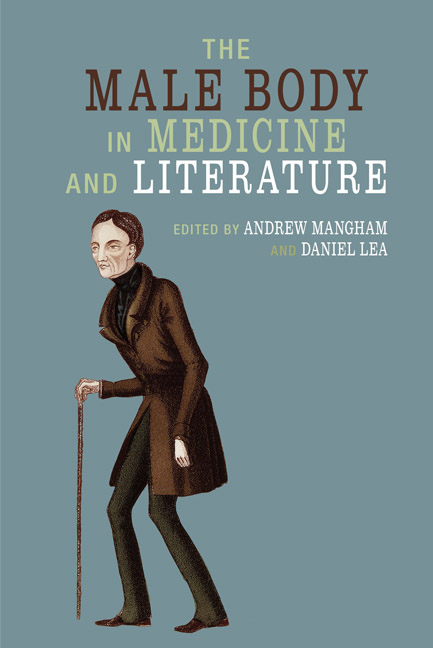Book contents
- Frontmatter
- Contents
- Acknowledgements
- Notes on Contributors
- Introduction
- Part One Enquiry and Experimentation
- Part Two Wounded and Psychopathologised Bodies
- 5 The Male Wound in Fin de Siècle Poetry
- 6 The Cacophony of Disaster: The Metaphorical Body of Sound in Don DeLillo's Falling Man
- 7 ‘Human Nature is Remorseless’: Masculinity, Medical Science and Nervous Conditions in Virginia Woolf's Mrs Dalloway
- 8 ‘A man must make himself’: Hypochondria in Maria Edgeworth's Ennui
- Part Three Fear, Confusion and Contagion
- Index
6 - The Cacophony of Disaster: The Metaphorical Body of Sound in Don DeLillo's Falling Man
from Part Two - Wounded and Psychopathologised Bodies
- Frontmatter
- Contents
- Acknowledgements
- Notes on Contributors
- Introduction
- Part One Enquiry and Experimentation
- Part Two Wounded and Psychopathologised Bodies
- 5 The Male Wound in Fin de Siècle Poetry
- 6 The Cacophony of Disaster: The Metaphorical Body of Sound in Don DeLillo's Falling Man
- 7 ‘Human Nature is Remorseless’: Masculinity, Medical Science and Nervous Conditions in Virginia Woolf's Mrs Dalloway
- 8 ‘A man must make himself’: Hypochondria in Maria Edgeworth's Ennui
- Part Three Fear, Confusion and Contagion
- Index
Summary
The physical and emotional trauma that Keith Neudecker, the protagonist of Don DeLillo's Falling Man (2007), sustains as a victim of the 9/11 terror attack on the World Trade Center essentially propels the emergence of a metaphorical body where repetitive patterns of various sounds – the noises of the attack as well as key phrases reverberating in internal and external speech – prove to be his sole anchor after conventional medicine only triggers his anxiety. While undergoing a medical procedure following the attack, Keith conjures up a morbid association that emphasises both his detachment from his body and his struggle with the saturation of sound, but also his disillusion or disbelief in the medical establishment:
The noise was unbearable, alternating between the banging-shattering sound and an electronic pulse of varied pitch. He listened to the music and thought of what the radiologist had said, that once it's over, in her Russian accent, you forget instantly the whole experience so how bad can it be, she said, and he thought this sounded like a description of dying.
In fact, Keith's initial struggle to reconcile his status as a survivor of the 9/11 attack is depicted through his physical injury within the context of an alienating hospital setting – ‘There were people on gurneys and there were others, a few, in wheelchairs, and he had trouble writing his name and more trouble fastening the hospital gown behind him.’ The medical procedures are also described in neutral terms from Keith's shell-shocked perspective, as if he were a ghost-focaliser, observing his physical body rather than existing within it:
Doctors in scrubs and paper masks checked his airway and took bloodpressure readings …. They studied the contusions on his body and peered into his eyes and ears. Someone gave him an EKG. Through the open door, he saw IV racks go floating past. They tested his hand grip and took X-rays. They told him things he could not absorb about a ligament or a cartilage, a tear or a sprain.
The metaphorical body of sound emerges in reaction to Keith's corporeal estrangement and ongoing state of sensory overload; both of these phenomena are triggered by the attack as well as by the medical treatments Keith endures following his survival.
- Type
- Chapter
- Information
- The Male Body in Medicine and Literature , pp. 103 - 119Publisher: Liverpool University PressPrint publication year: 2018



